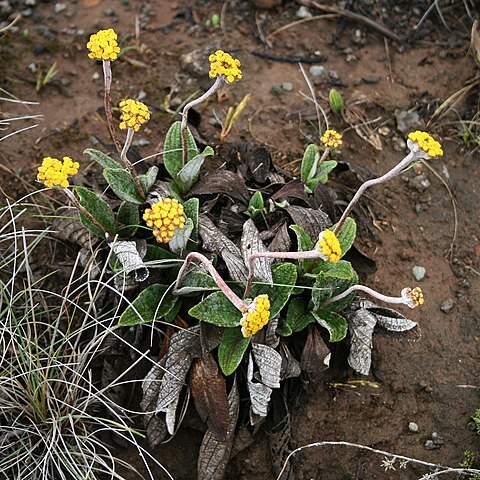Perennial herb spreading by stout underground runners, flowering stems solitary, simple, up to ±1.5 m tall, leafy below, pedunculoid upwards, thinly woolly. Radical leaves up to 600 x 130 mm, but often only half that or less, linear-lanceolate, elliptic to ovate, more or less abruptly, or sometimes gradually, contracted to a narrow or broad and then winged, petiole-like base, apex acute, margins sometimes undulate, upper surface scabrid, lower scabrid, cobwebby or thinly to thickly white-woolly, (3-)5(-7)-nerved, nerves strongly raised below, linked by netted veins; cauline leaves similar, sessile, stem-clasping, lower ones particularly sometimes strongly decurrent, becoming smaller upwards and rapidly passing into distant bracts. Heads homogamous, narrowly campanulate, ±4-5 x 2.5-3 mm, very many in a large corymbose panicle. Involucral bracts in ±6 series, closely imbricate, woolly at base, obtuse, pellucid or subopaque, pale or lemon-yellow, outer sometimes palest brown, equalling the flowers, not radiating. Receptacle with fimbrils at least equalling ovaries. Flowers 16-32. Achenes 1 mm long, glabrous. Pappus bristles many, equalling corolla, scabrid, bases lightly fused and also cohering by patent cilia.
Perennial herb, up to 1.5 m high. Radical leaves up to 600 x 130 mm, linear-lanceolate, elliptic to ovate, petiolate, margins sometimes undulate, upper surface scabrid, lower scabrid, cobwebby or thinly to thickly white-woolly; cauline leaves similar, smaller, sessile. Heads narrowly campanulate, many in large corymbose panicle. Flowers with involucral bracts pale or lemon-yellow, outer sometimes palest brown.
Subshrub with erect, peduncle-like stem to 1.5 m from a woody rootstock, thinly woolly above. Leaves mostly radical, oblanceolate, glabrescent but margins and veins roughly hairy, 3-7-net-veined from base. Flower heads discoid, many in a branched corymb, campanulate, pale yellow or brownish, ± 4-5 x 3 mm, florets 15-30, ovary glabrous.
A herb. It grows up to 1.5 m high. It has stout underground runners. It keeps growing from year to year. The leaves are long and narrowly oval. They are hairy underneath. The flowers are in loose heads on branched flower stalks. They are pale yellow.

